The Millenium Series
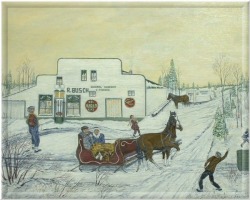
CAMPER CIRCA 1941 - (SETTLED 1912)
"Walking hand in hand toward the future: one staggers to realize the amount of effort and dedication it took to tame this wonderful wilderness."
In the heart of what was once the bustling community of Camper stands a Cairn with an inscription that reads; In memory of the brave pioneers who in early 1900 homesteaded the Camper area and who through their sacrifices endowed us with a heritage we will forever cherish. The fire of 1989 destroyed all recognition of Camper except the community hall and New Horizons Center.
Pioneers settled the Camper area as early as 1908. The town came into being in 1912, and was named after a Roman Catholic priest Father Camper. The town progressed to where there were four stores; a creamery; Municipal offices; a flourmill; butcher shop; Smithy and Harness Repairs; grain elevator; stock and Post Office. Two hotels and a number of boarding houses provided accommodations for travelers and workers in the community. In 1910, a Jewish colonization took place two miles east of the town. In spite of a lot of effort, it eventually dissolved as the people sought out other places to live and work.
In 1914, WWI called a number of men into service. Many sacrifices were made at home and abroad with the most difficult being that very few men returned. Whether men had gone to war or had to seek employment elsewhere to earn a living, women were left alone with children; loneliness; lack of conveniences and fear of the wilds. Night time brought the howling of wolves that emphasized the isolation of pioneer life.
Adina Hoffman (age 76) and husband Ted (age 81) spoke of many hardships, but also highlighted many joys. They spent a lifetime of community service through a variety of venues. The Interlake Moms and Dads brought many enjoyable hours to the community with their ‘down home country style’ music. Adina and Ted’s message to the younger generation is Slow down, don’t live so fast, life passes too quickly.
Busch’s Store was chosen to represent Camper as it was the last business to close its doors in 1980. Rudy and Irma Busch were the last proprietors of this long loved general store. The silence of what was Camper still holds the indomitable spirit that christened its beginning. We will never forget.
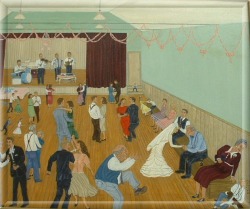
FAULKNER CIRCA 1955 - (SETTLED 1910)
"A community is more than a population of people; it is where two or more are gathered in harmony in the spirit of caring for each other."
Kathy Gibson (age 83) tells when she and her parents came to Faulkner with horses and wagon; Kathy and her mother had to be strapped to the wagon to prevent them from falling off. Cars now travel in ease where the settlers were unable to walk. Adolf Sidof relates in the history book Hardship and Happiness that there were no roads, only trails, and the men folk had to mark the trees to get from place to place. There were no graded roads until 1940.
Faulkner was named for an elevator agent who travelled to the area from Winnipeg. The town consisted of a couple of stores; post office; flour and saw mill; blacksmith shop; garage; station house and the Anglican Church. The Aston Villa School was not located at the town site, but was the school that the area children attended. It was opened in 1915, and eventually closed in the mid nineteen sixties.
This little village has left its mark on the area mainly because of the community spirit it promoted. It boasts a Women’s Auxiliary, 4-H Club and a community club. The first community hall was completed in 1953 with the final touch of the hardwood floor in 1955. Albert Reese (age 79) relates that it took ten years to raise the thousand dollars to build the hall. The first fund raising event was a card party, which raised a total of two dollars and fifty cents. Art (age 82) and Brita (age 89) Kaus relate that the locals would spend many hours after dark working on the hall; they had no daylight hours to spare. This hall was replaced with a new one in 1989. No matter which hall, the memory of the local musicians and the wonderful functions held there will always remain with many folk in the local and surrounding area.
Faulkner certainly does not lack for talent. The music of the Springers, Gerings and Rich Middlestead; the art of Erich Hofbauer; love stories of Miss Diaz, and the poetry of Mary Burnett helped to enrich the lives of many of yesteryear and today. Mary Burnett (age 80) says her message to the younger generation is, Hard work never hurt anyone, work hard. It is certainly with this work ethic that the pioneers were able to confront the wilds of this country and tame it for the basis of what we enjoy today.
The focus of the painting is a wedding dance located in the first hall. My own recollections as a youngster growing up in the area definitely includes the many happy occasions spent there. Faulkner is still promoting community functions and will continue to build this legacy of enjoyment for generations to come.
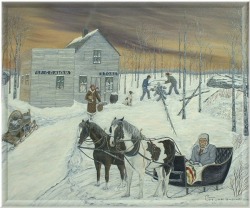
GRAHAMDALE CIRCA 1913 - (SETTLED 1912)
"This wonderful land was given to the hearts and hands of those who came to start life anew."
Grahamdale, formerly known as Deerfield, was a center that provided health care at the Red Cross Post; education at the school; general supplies at Sam Graham’s Store, and a place to practice religion at the St. John’s Lutheran Church. It time there were additions to the services which helped make pioneer life more comfortable. The efforts of a community of individuals resulted in amenities for the pioneers, which are still with us today. They built a community for everyone to enjoy, and built character within themselves.
In conversation with Emma Ashley (age 93), she spoke of many miles walked to and from town to get supplies when she was a child. During winter months, she would ind herself arriving home at dark amid the howling of wolves nearby. She learned not to be unnerved by this. When asked what message she had to give to today’s generation, she said, Learn all you can, you never know when you’ll need it.
In speaking to Oscar Mangl (age 83), he recalled fond memories of the camaraderie shared with neighbors during the hauling of lumber from Reedy Lake to Grahamdale and surrounding areas. Oscar also recalls the howling of the wolves which could be quite ‘blood chilling’ on a lonely, frigid winter night. He has gained a respect for the land and believes the Interlake is a good place to live. His message to the generation of today is get a good education. He understands how the past calls people to learn about their environment and what it requires to create a balance of existence for all.
There are many other names who are worthy of mention, but space will not allow . One person in particular, Sam Graham, was instrumental in obtaining many of the community services. His store and boarding house were the focus for the town. I felt it was fitting to center my painting around the same.
Grahamdale is a lot smaller now, but stands as a landmark for all of the important people who carved their lives out of this wilderness, and provided a legacy that we can enjoy and appreciate today.
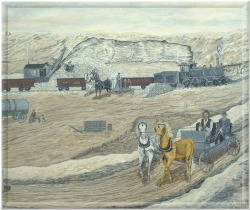
GYPSUMVILLE CIRCA 1929 - (SETTLED 1911)
"The kinship our ancestors developed with this land is the grace that warms and sweetens our lives."
The discovery of gypsum in 1888 by a Mr. J.B Tyrell led to the establishment of the first Gypsum Mill in Manitoba situated at Portage Bay, Lake Manitoba and by 1900 a quarry twelve miles away that was mined by the Manitoba Gypsum Co. Due to the swampy conditions, the rock was hauled by horse and sleigh in the winter months to the Mill for processing and was subsequently shipped by boat to Winnipeg. Between 1904 and 1905; a railroad from the quarry to the Mill was added and a locomotive, The Dinky, was employed to transport the rock year round. The settlement of personnel near the quarry became large enough to require a school and was known as Gypsumville. The destruction of the Gypum Mill by fire in 1908 initiated the decision to move the Mill to Winnipeg. This led to the moving of Gypsumville to the end of the CNR Railway line, better known as the ‘back camp’ in 1911. The first settlement became known as Davis Point and the back camp became what is now known as Gypsumville. With the advent of the railroad, The Dinky was no longer required. The town now included the school; new company office; company store; boarding house; several private homes and also the services of the telegraph. The first local freight train brought a steam shovel for the quarry allowing the retirement of horse drawn scrapers, wheelbarrows and pick and shovel. With the prosperity the mine brought to the area, it also brought its first casualty. The foreman, Mr. George McCallum, lost his life in an accidental dynamite explosion. The train that took Mr. McCallum’s body to Winnipeg for burial, also took the first cars of Gypsum rock to Winnipeg by railway instead of by boat. The Gypsumville Company was the heart and soul of the community with an employee count of anywhere from 40 to 80 people. Presently, the mine is owned by Georgia Pacific of the U.S.A and is non -active.
Prior to 1914, Dr. Clark (a Baptist Missionary) offered medical and spiritual services to the area. Dr. Clark left Gypsumville at the onset of W.W.I, leaving the area without any medical services until 1929. This marked the arrival of missionaries from the Woman’s Society of the United Church of Canada who set up a medical centre at a Gypsum Company’s building and the year 1934 saw the completion of the United Church. The health services have undergone a variety of changes through the years with the most recent being the opening of the Health Clinic in 1982.
The Women’s Institute organized in 1919 was responsible for a variety of services that the community enjoyed, including Christmas concerts and local fairs. This institute also established the local cemetery; doctor’s clinic; dental services; library books; aiding in the funding of the Memorial Hall; Interlake Music Festival; Red Cross Swimming lessons; a history book; defensive driving courses; Home Economic courses; Boy Scouts and made numerous donations to worthy organizations. Mrs. Pearl Dawyduk was presented with a plaque for 50 years of service since 1987.
One cannot forget those who developed the land through much physical labor namely the farmers. Many of the men worked by day at the mine, and evening at the farm. Men, women and children worked together to achieve what we witness today. Dorothy Rawluk’s father, Alex McCurdy, coined the phrase ”Tomorrow will be a better day“. So it is for our generation, and generations to come.
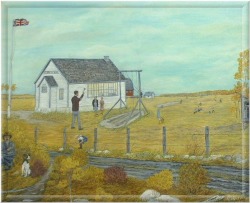
HILBRE CIRCA 1937 - (SETTLED 1912)
"As much as we are one as a community, so are we are at one with this land."
The year 1911 brought the railway through what is now Hilbre and subsequently, in 1912, a siding was built. It is believed that Hilbre was named for a railway worker who was killed on the job and buried there. Another source for the name suggests it is named for an Isle off the coast of England; possibly an immigrant survey member named it for his home. In any event, Hilbre became home for many immigrants from Holland; Sweden; Ukraine and Germany.
Hardship accounts in Passports to the Past mention horses that were pulled through four feet of water with oxen and horses that would lay down in snow banks too high to pass through. The mosquito problem in the summer caused people to carry smudge pails to alleviate the discomfort.
Amelia Mayer lived for all of her one hundred years in Hilbre; she expressed the sentiment, ”They were sad times but happy and good times. I like to remember them.“ She represents the spirit that was present in all of the pioneers, including Dick Palm and A.W Kirvan. Dick Palm, owner of the General Store, was the strength that helped many families through the ‘dirty thirties.’ A.W Kirvan was the first sitting Legislative member for the Constituency of Fairford established in 1920. He was very active in community events and established the baseball trophy known as the Kirvan Cup.
The Hilbre School was chosen to represent Hilbre as it was the focus of community life in general. It housed most community events and still lives in the hearts of many who resided there. On the right side of the painting, notice the small building better known as ”The Booth“. This was a concession stand that supplied students with treats. The ”Shield“ was an award given to the school of highest athletic standing in the area. It became the inspiration for the children to build a school spirit which exists even today.
Hilbre is a true representation of the spirit and grit that was required to settle this land. It is such small but warm communities that have always played their part in forming our national identity. Hilbre has always been and continues to be an inviting community to visit.
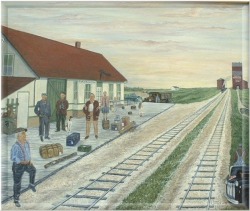
MOOSEHORN CIRCA 1941 - (SETTLED 1908)
"As giving as this land can be, so it can be most unforgiving to those who choose not to respect and protect it"
The settlement of Moosehorn began in 1908 when surveying was done to organize the area into sections. In 1911, the railway established a siding around which the town was built. There were many difficulties surrounding this land due to the lack of drainage. In the history book ”North West Interlake“, Mr. Herbert Watchorn relates how the survey crews at times were trekking through water waist deep, and through terrible tangles of willow in order to establish their steel line measure every half mile. The highway was established by 1946.
In speaking to Myrtle Buechler (age 91), she recalls at age three and a half how she and her family arrived in Moosehorn via the train from Winnipeg, and travelled to Ferdinand Helm homestead with horse and buggy. They drove into pools of water as they labored over a trail that led through meadows and bush toward their destination. They stayed at the Helm homestead until they could secure a place for themselves. Myrtle mentioned that the small homestead was so crowded that she and other children ended up sleeping on the floor behind the stove. It was a cozy spot, but a mixed blessing when Myrtle burned her hand. She also spoke of a drainage problem. She witnessed many horses stuck in the swampy terrain on the pioneer trail. Her message to the present generation is, ”life was good, and still is.“
I have chosen the CN station; Parish and the Heimbecker Elevator as my theme for Moosehorn. Life revolved around these services to a large degree. Unfortunately, these services no longer exist. I found it most gratifying to be able to preserve their memory on canvas. The people portrayed are local people some living, and some have passed. I regret that space does not allow for me to include all the many interesting people who helped in the development of this town. For those who hold a special place in their hearts for Moosehorn, there is a beckoning to return from near and far.
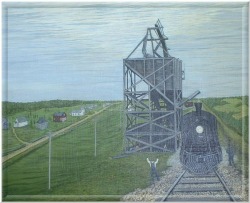
MULVIHILL CIRCA 1929 - (SETTLED 1908)
"The orchestra of yesterday still plays the music for today and tomorrow."
The arrival of the Railroad in 1911 brought more settlers with hopes and dreams that would help to make Mulvihill a thriving community. It boasted a number of businesses that serviced people from Vogar, the Narrows and the surrounding area. This commercial center was comprised of a livery barn and horse drawn taxi; blacksmith shop; butchershop; sawmill; garage; boarding house; pool hall; stores; fish sheds; school; church and the coal dock.
The coal dock was a structure of eighty-six feet in height that held eighty tons of coal which was the yearly supply for the steam locomotives that travelled the line. The coal was transported to Mulvihill via box cars that held approximately forty five tons. This was hand loaded onto trolleys that were conveyed to the top of the structure and dumped into the bin for storage. Winter sometimes proved to be quite difficult as the coal would freeze and would require the aid of the coal dock operator. I can just imagine the dread that would permeate the soul of the coal dock operator when he would hear the three blast train whistle to indicate that he was required. I’m sure this would always happen on the coldest of nights.
The school was opened in 1911 and was replaced by another in 1928, then subsequently a third in 1940. The year 1968 was the final year of operation.
In 1954, the Prairie Farm Re-Habilitation Administration located a community pasture 2 ½ miles north of town, which covered eighteen thousand acres of land, with approximately sixty miles of fenceline. The pasture was increased in 1963 with the addition of Sleeve Lake Community Pasture, and became known as the Mulvihill Community Pasture under Agriculture Canada.
Mulvihill suffered its share of pain with the onset of the Spanish Flu in 1918, and a fire which claimed four businesses in 1919. These disasters did not quench the spirit of the settlers as there was always time for fun with the music of local musicians at barn dances or the Legion.
Andrew Mikula, a local farmer and operator of the coal dock recalls the many difficulties experienced in earlier years. He has had many experiences in his 85 years, and leaves this message to the younger generation.” Do not forget that what you are accomplishing today is building on the struggles of those who have gone before.“
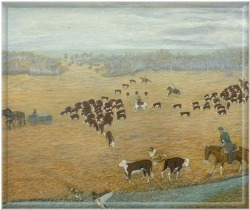
PEONAN POINT CIRCA 1935 - (SETTLED 1914)
"A lifetime of accomplishments can only be truly measured by the love shown toward our fellow man.”
Peonan Point is a peninsula that extends more than twenty miles south of the north shore of Lake Manitoba. It became the site of a Hudson’s Bay Post in the 1880’s. Due to its native grass meadows, ample water and shelter for winter feeding, the early settlers recognized the livestock potential for ”The Point.“
In spite of its inaccessibility, ”The Point“ developed a solid reputation for Manitoba beef herds in Western and Eastern Canada and the U.S.A. This can only be attributed to the perseverance and hard work ethic of the pioneers who settled this wild and wonderful place. Some of the hardships faced by the settlers would include isolation, flooding, fires, animal diseases not to mention the harsh Manitoba winters. An account by Petra Anderson in the ” Hardships and Happiness“ history book, relates the loss of one third of the herd to the disease of Septicaemia in 1922.
Some of the family names who first settled were: Burns; Thompson: St. John; Olson; Pike; Wilson; Rawluk; Snidal; Gislason; Anderson; Grealy; Ketchur; Solise; Nord and Hjartarsons. Eric and Eyvi were the last of the Hjartarsons to ranch on ”The Point“ until the ranch was sold to the Cooks in 1979.
Eric Hjartarson, (age 82) one of eleven children, fondly recalls the many years of work and play. His accounts of the early years include haying up to 150 stacks per season with horses; milking a herd of 50 cows, and feeding animals in the winter by hand. Cattle driving the herd to St. Martin in the fall for shipping to Winnipeg, and dealing with early and late ice on the lake helps one to understand the tremendous resolve it took to ranch on ”The Point.“ The fear of childbirth in isolation was relieved by Eric’s mother, Sigrun. She was the local midwife for many years. Eric holds the love for his family and friends very close to his heart. One person he speaks of with very high regard is Sylvan Baker. Sylvan was Eric’s hired hand who was as much a son to him as anyone could be. In spite of all of the hardships, Eric relates many of the fun times as well. He recalls New Year’s Eve, Fishermen’s dances and Box Socials with much delight.
I chose the cattle drive as the focus of this painting as it was an integral part of ranching on ”The Point“ in the early years. Until the arrival of the barge, all herds were transferred to the railhead in this way. For the most part, the cattle drive was very manageable with the possible exception of break time as depicted in this scene. The cattle could become distracted and would create a melee that required hurried attention.
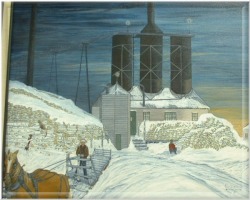
SPEARHILL CIRCA 1925 - (SETTLED 1911)
“No matter how man disturbs mother nature in the harvesting of her bounty; the land shows immeasurable forgiveness by graciously healing the scars with a rich regrowth of plant life.”
Spearhill was settled in 1911, mostly by Scandinavian immigrants from Norway. In 1913, The Manitoba Gypsum Company built kilns for the processing of limestone nearby with J.R Spears in charge of operation; thus the name ‘Spearhill.’ The company accommodated the personnel by building a boarding house; store/post office; dance hall and a number of dwellings. In 1920, the mine was sold to Winnipeg Supply and Fuel Company, which operated it until its close in 1976.
The mine experienced many changes through its years of operation. Changing from wood to coal to fuel the kilns, from horses to trucks and tractors to pull the rock cars and the increase in the number of kilns with new excavating equipment brought the mine up to modern day standards. The mine experienced a number of setbacks such as the Depression of the thirties, and the fire of 1946. The fire destroyed the water tank; power house and two diesel motors that provided electricity to the plant and homes. There were fatalities, which took the lives of Henry Uvaan; Henry Marceinkowski; Herman Eisfeld; Blair Fenning and Wayne Bucholtz. The sadness of these fatalities reverberate in the lives of many today.
Spearhill’s spirit of community was one to be rivalled. The dances; pie and box socials; whist drives; singsongs and concerts helped to make life a joy for the populace. For sports, there was baseball; basketball; curling and hockey teams. Fred Blocksidge, who became an amateur welter weight boxing champion held exhibitions in Spearhill. His picture is in the Sports Hall of Fame.
During WW II, the B.C Securities Act imposed internment on Japenese families living within 100 miles of the pacific coast. This brought some families to Spearhill to be employed at the mine. This period did not leave a scar on Spearhill as the Japenese were readily accepted as part of the community. Some of the family names of the displaced were Yonimoto; Furikawa; Oike and Kusano. Roy Sveinson relates that when inspection rounds were made the Japanese were to be guarded by personnel. One day, his father Gus Sveinson was to be on guard when he was caught pounding the rock while the ‘prisoner’ was holding the gun. I suppose one does not have to say much more about the heart and soul of Spearhill.
The early kilns, with the cord woodpiles were chosen as the focus of the painting as this was the beginning of what became a fondly remembered community.
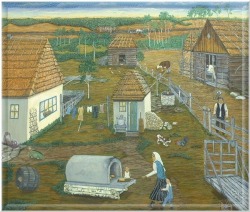
ST. MARTIN CIRCA 1920 - (SETTLED 1910)
“Our ancestors have entrusted us with a legacy to maintain and uphold. Let’s bind our hearts in unison with the desire to hold to the past with its lessons and look to the future with its challenges.”
The swampland was impossible to homestead. There was no drainage; the thick jungle like vegetation prevented the wind from drying the surface. The ground was covered with dead grass, with fresh green growth coming through. Every quarter mile or so, there would be a beaver dam keeping everything flooded. In dry years, the settlers were able to cut the hay, but in wet years it was impossible. This account in the history book “North West Interlake Heritage” gives a brief glimpse into the past with its challenges. The Ukrainians of St. Martin had an indomitable spirit and work ethic, which allowed them to eke out a living from this untamed wilderness and build the base of what we see today.
The arrival of the Canadian National Railroad in 1911 brought more settlers to the area and provided the only mode of transportation to Winnipeg. Local transportation was via the ‘dinky track’ (a gypsum transport line from the quarry to the mill), and corduroy roads that led through the swamps. ”The horses sunk to their bellies and the wagon box occasionally got wet“(quote from the North West Interlake History book).
With the influx of settlers, Karpaty School was opened in 1916 and remained in operation until 1977. During the 1920’s, the school was overflowing with students, and an overflow school was opened in a vacant farmhouse. It was opened close to the C.N.R water tank, and the farmhouse became known as”the Tank School. “
The main sources of livelihood were farming; fishing; cutting cordwood and mink ranching. Coupled with a general feeling of goodwill toward your neighbor, one of the endearing traits of the settler was that no one was ever turned away from their door. The main sources of entertainment were weekend dance parties; the Christmas concerts and the annual picnic. St. Martin boasted a baseball team that would challenge teams from Gypsumville and Fairford.
Dan Obsniuk, age 87, is always very thankful that his parents immigrated to Canada at the time they did. They were booked to travel via the infamous Titanic, but were delayed by circumstance and cancelled the trip until later. Dan’s advice to the generations of today and tomorrow is,”Learn how to make a living and how to take care of yourself. “
The Ukrainian farmstead was chosen as the focus of the St. Martin painting as farming was the main industry of the area. It remains as such today.
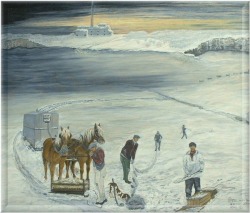
STEEP ROCK CIRCA 1925 - (SETTLED 1913)
“The hands of those who cultivated and foraged this land still join with ours today in celebration of life.”
In the fall of 1913, Canada Cement Lafarge Co. opened the Quarry pit for operation. The plant operated only in the summer months during the thirties, which led people to supplement their incomes through winter fishing and farming. These industries caused Steep Rock to become a growing and thriving community.
The year 1913 was significant for Steep Rock; The Railroad and telephone service arrived and two stores and a fish shed were built by the Fairford Trading Co. and The Armstrong Trading Co. From 1914 until 1919, a cream boat service; passenger train service; school and telephone were added. The United Church missionaries arrived in 1923, which eventually led to the building of the church in 1957.
During my interviews, I found one person who is fondly remembered for his generosity and community mindfulness. Fiddi Snidal, owner of the General Store, extended credit for long periods which allowed many families the opportunity to continue on. Eric Hjartarson (age 81) recalled the incident when Fiddi loaned money to a hired hand so he could attend his mother’s funeral.
In spite of all the hard work required, Steep Rock had a unique presence of fun and laughter. Ed Bednarek (age 72) and Lynden Shiells (age 78) recall fond memories of many dances held in town especially New Year’s. The arrival of as many as thirty cabooses from far and near presented an air of excitement to be rivaled only by the enchanting music of Simon Nord; Ruben Larson and Harry Wallman. Ed and Lynden mentioned that there were a lot of activities for the children, and recall the 9:00 p.m curfew that always provided a challenge.
The uniqueness of Steep Rock is not only told in its history of hard work; perseverance and love of life, but it is also displayed in its natural beauty. Steep Rock will always hold a special place in the hearts of those who explore it.
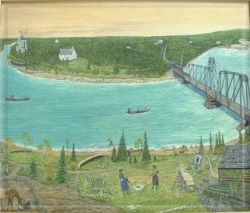
FAIRFORD CIRCA 1912 - (SETTLED 1795)
"We are all sisters and brothers lets unite our hearts and spirits toward a better tomorrow. Today is the history of tomorrow."
Before the settlement of the Europeans, the Saulteaux were the keepers of this beautiful land. They were a branch of the Ojibway from the Sault St. Marie area and were known for their peaceful existence with other tribes in what is now known as Manitoba. According to Mr. Dobbs, a Saulteaux native missionary the peace was abruptly disturbed when the Sissetones from the Dakotas attacked the settlement and exterminated most of the Saulteauz with the exception of a small band led by Wooden Tent. He led his men to Berens River from where they organized their retaliation over three years. This carefully orchestrated reprisal resulted in the complete massacre of the Sissetones which allowed the Saulteaux to flourish again. Wooden Tent stands as a hero in Saulteaux history. His descendents, the Woodhouses live in Fairford today.
Fairford’s original name was Pinaymootang, meaning partridge crop. The name Fairford was adopted in honor of Rev. Abraham Cowley who established the first mission for the church of England in 1842 and was instrumental in helping the natives adapt to the white man’s ways of farming and religion. He was from Fairford, England. The Northwest Company set up a post in 1795 The Hudson’s Bay Company, in 1819. In 1821, the companies amalgamated and ran the post under The Hudson’s bay name until 1912. The arrival of the railway in 1911 foreshadowed many changes for the Natives and the European alike. Time has brought both good and bad for both cultures a challenge for today and the future.
I spoke to Louis Letandre, aged 80. He fondly recalls the childhood activities of his time which included jumping the train as it arrived in Fairford, to ride it to the water tower north of town. Louis is part Ojibway and French and speaks Saulteaux. Jenny Watt, aged seventy six, was a warbride from Holland who recalls the dense brush and the kindness shown by neighbours. She says she has never regretted her move to Canada. Gladys Moar, aged eighty five, recalls life in a residential school which has left an indelible mark on her life. She believes that time hasn’t necessarily produced happier people, as people then had taken more time for each other. It is with this mix of heritages that Fairford retains its color and uniqueness today.
I chose to do the trestle bridge north of town as the focus of my painting as it includes the north bank of the river that was a Metis village in 1912, and before that a Native settlement. The Grist Mill in the middle left of the canvas and the Hudson’s Bay post in the far upper right no longer exist except in the annals of history. St. Helen’s Anglican church; Topnick’s store and the trestle bridge still stand today as landmarks of Fairford’s colourful past. You will notice that the activities depicted represent a wonderful blend of both cultures.


